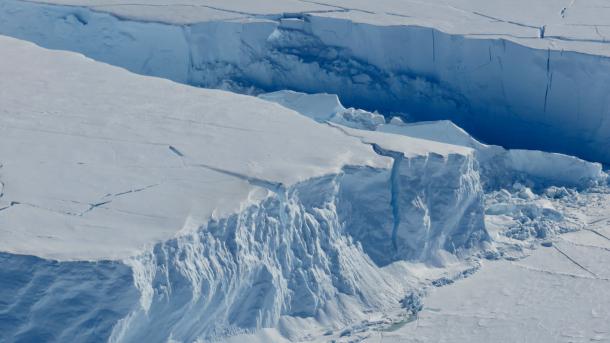The melting and collapse of Thwaites Glacier could affect sea levels for years to come
Thwaites Glacier is one of the largest in the world, about the size of Florida. If it melts completely, it will raise sea levels around the world by around two feet — but that might be just a start.
Some scientists suggest the loss of Thwaites from the West Antarctic Ice Sheet could uncork even more massive amounts of ice behind it and lead to many more feet of sea level rise. That is why some have dubbed it the “Doomsday Glacier.”
“If you were to argue, what is the most important glacier in the world, it would certainly be Thwaites Glacier,” says glaciologist Karen Alley, an assistant professor in the Centre for Earth Observation Science, Environment and Geography at the University of Manitoba.
“Thwaites is huge,” she says. “It’s a little bit bigger than the state of Florida. So this is a tremendously large tract of ice, and it is retreating, it is changing very quickly, it is contributing to sea level rise. We expect it to contribute much more to sea level rise in the future.”
Whether to call it the “doomsday glacier” depends on how you look at it, Alley adds.
“It certainly is something that we need to be paying attention to,” she says. “It is very important, it is changing, it is going to affect communities all over the world as sea level rise continues. But it’s also something that we can learn about and prepare for.”
The changes to Thwaites that concern scientists are going to happen on a timescale measured in decades and centuries, which gives humanity a chance to understand what’s happening now and to prepare for changes that might occur in the future, Alley points out.
Thwaites is of special concern for another reason: it sits at the outlet of the huge amount ice that makes up the West Antarctic Ice Sheet. This ice sheet is special, Alley says, because it’s so large and because the shape of the land it sits on makes it unstable.
Glaciers tend to be stable and change slowly if the land they sit on slopes upward from the coast. The West Antarctic Ice Sheet does the opposite, Alley says. It gets deeper further inland from the coastline, which is not a stable configuration.
If a glacier begins to retreat and has that kind of shape to its bed, a feedback loop of melting and retreating can begin that is hard to stop, Alley warns.
If the melting of Thwaites and other glaciers continues as scientists fear, sea levels will definitely rise over the next few centuries, Alley says.
“In the near term, that translates to centimeters [or] to maybe tens of centimeters in our lifetimes, but those are numbers that are very difficult to predict with a lot of certainty,” she explains. “We kind of know the end state. We know that Thwaites could retreat all the way back to the Transantarctic Mountains. And in that case, we’re looking at a few meters of sea level rise. But the pacing of that and the amount of that in the meantime is very difficult to predict.”
Related: Rapid ice melt and sea-level rise will be part of our global future — no matter what
Right now, global sea level rise is a few millimeters per year and Thwaites Glacier contributes about 4% of that, Alley says. This may seem like a small number, but the Greenland ice sheet and other glaciers contribute to sea level rise, as well. Sea level rise also occurs because water expands when it warms, which the ocean is now doing as it absorbs large amounts of carbon dioxide.
While there is a lot that scientists still don’t know about Thwaites Glacier, “we definitely know the direction things are going,” Alley says. Thwaites is retreating and is contributing to sea level rise. Scientists don’t yet know, however, if it has reached a tipping point.
“There’s a chance, if we can keep warming down so that it doesn’t get too high, that Thwaites might not retreat all the way,” she says. “So being proactive about global climate policies is really important. It may keep Thwaites from retreating all the way.”
“I call sea level rise a ‘here-and-now problem’ because there are already coastal communities being impacted by sea level rise,” Alley adds.
“But those impacts are going to get much larger in the future, even if we don’t push Thwaites over a tipping point. … It’s hard to plan that far in the future. But it’s something we have to do. It’s something that we know is coming. So it’s something we need to start thinking about, responding to now, or we’re going to see really huge impacts — which we’re already starting to see, particularly on vulnerable communities that live in coastal regions.”
This article is based on an interview by Jenni Doering that aired on Living on Earth from PRX.
Related: If Thwaites Glacier collapses, it would change global coastlines forever
